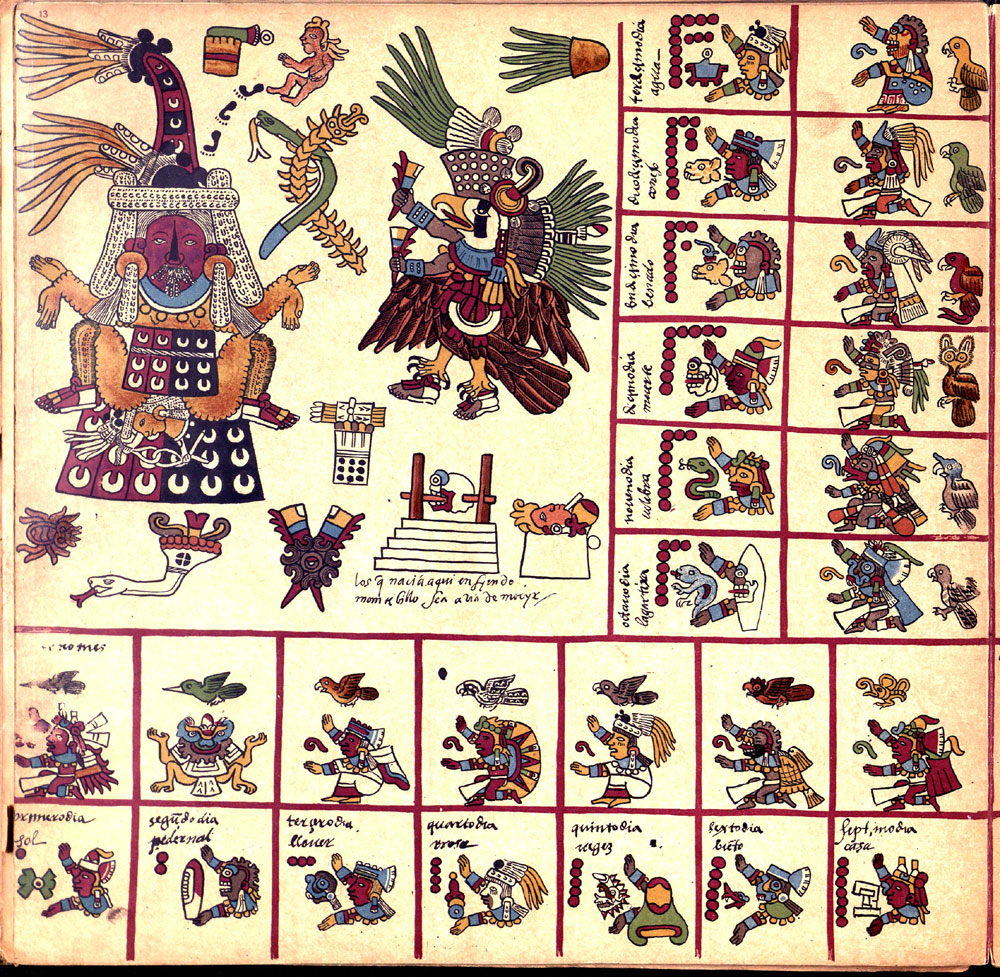Before the Spanish invasion, the diet of the Aztecs of Mexico was dominated by vegetables and fruit, although wild game was also important (rabbits, fish, birds, salamanders, frogs and insects). Their most important staple was maize, eaten in a gruel and made into dough for tortillas and tamales. Other common foods were amaranth, beans, squash, chili peppers, tomatoes, potatoes and peanuts. Blue-green algae was harvested from Lake Texcoco and dried and cut into bricks which could be stored up to a year. They ate lots of fruit including avocados, guavas, papayas, custard apples, pineapple, prickly pear (tuna), chirimoyas and zapotes. They also snacked on popcorn. Popular flavors were vanilla and cocoa.
The cocoa beans were fermented, roasted in the sun, ground into powder and mixed with hot water and made frothy with whisks. This drink was often flavored with maize, vanilla, chili peppers, herbs, and honey. Cocoa was so esteemed across Mesoamerica that its beans were used as currency and commonly demanded as tribute.
The Aztecs not only grew crops in their fields but also ornamentals. Flower gardens were found all across Tenochtitlan. The most famous was Moctezuma’s exotic garden at Huaxtepec, but most of the upper class had their own pleasure gardens.
Culture and Land Use
In Aztec society, land was either owned by communities and allocated to families for farming or was privately owned by the King and farmed by tenants (other Aztec nobles or warriors given land for services rendered). These tenants paid rent to the king through intermediaries. There was a hierarchy of agricultural workers – landless laborers and slaves who worked the Kings land and other specialized horticulturalists who managed the farms.
Common people could not own land themselves, but they had access to land through neighborhood wards called calpulli. These were led by a single nobleman and a council of local elders. Although the calpulli were run by nobles, the commoners were permitted to elect a neighborhood leader (calpullec) to manage the distribution of the land. This land was given to individual families, and generally stayed with the family unless it went uncultivated for two years or the family moved away. If this occurred, the unused land would then be redistributed to other families.
Aztec were great record keepers and much information about agricultural methods and timing was maintained in the “tonalamatl almanacs”. This rich heritage was lost forever when it was destroyed by the Spanish after conquest to remove all records of the Aztec pagan heritage.
Eco-geography and agricultural practices
The Aztec Empire spanned almost all the agroecological zones of Mesoamerica. Including the hot and humid Gulf Coast Plains, the temperate lands of the coastal piedmont and the Mesa Central, and the high reaches of the Sierras separating the basins.
The Gulf Coastal Plain and Piedmont were populated by the Totonac, who cultivated the well-drained, rainfed, often sloping terrain. They incorporated terraces with rock-walls and earthen embankments, and they planted along the margins of wetlands as they receded during the dry periods. They also developed canals to irrigate wide areas. Two types of orchard-gardens were grown by the Aztecs – household gardens where maize was intercropped with beans, squash, cotton, tuna (cactus) and root crops, and orchards where cocoa and other fruits were grown for commercial purposes and tribute.
In the Mesa Central, a large Totonac population was present, organized around city-states that paid tribute to the Aztec. Small villages were scattered across the hinterlands of the City States. The Mesa Central was made up of broad, flat floored basins surrounded by towering volcanoes and broad slopes. The upper and lower reaches were covered by flights of gradually sloping semi-terraces anchored by cacti at their brims. Maize, beans, and squash predominated in the region, but amaranth, tomatoes and chiles were also grown.
Rainfed agriculture dominated on the slopes, but in the lower regions weirs and dams were built to collect run-off and spring water, and canals were dug to distribute the water. In some cases, seasonal and permanent wetlands were transformed with canals into farmland where agriculture could be conducted year-round.
Wetland cultivation was a high art in the Basin of Mexico, where chinampas or “floating gardens” occupied thousands of hectares in the freshwater lakes of Chalco and Xochimilco. Chinampas were narrow artificial islands (30 x 2.5m) constructed of dredged muck and biotic material in marshy areas and anchored by trees on their edge. Canals were maintained between each plot that could be traveled by canoe. The water levels were controlled by a complex array of aqueducts, dikes, dams, canals, and sluice gates that could also be used to irrigate the surrounding agricultural fields. The chinampas were state owned and controlled, and produced tremendous amounts of food, feeding perhaps 200,000 in the Aztec capitol of Tenochtitlan.
Agricultural tools and implements
Aztecs used relatively primitive tools for farming and did not have plows, as there were no large, domesticated animals in Mesoamerica to pull them. Copper and bronze were used for basic farming tools or weapons, such as sharp sticks for digging, club-heads, knives with curved blades, axes, chisels, needles, and pins. They used a cord to bear a load on the back called a Mecapalli. Perhaps the most important tool in Aztec farming was a wooden digging-stick, called uictli.
Illustration:
Page 13 of the Codex Borbonicus of the Aztec sacred calendar (tonalpohualli). The goddess Tlazolteotl, is portrayed wearing a flayed skin, giving birth to Cinteotl. (Licensed under the Creative Commons Attribute – Share Alike 3.0 Unported)
Bibliography:
Cartwright, M. (2014). Aztec Food & Agriculture. World History Encyclopedia. Retrieved from https://www.worldhistory.org/article/723/aztec-food–agriculture/
Coe, M.D., Urcid, J. and Koontz, R. (2019) Mexico: From the Olmecs to the Aztecs. Thames & Hudson, New York.
Hancock, J. F. (2022) World Agriculture Before and After 1492: Legacy of the Columbian Exchange | SpringerLink
Whitmore, T. M., & Turner, B. L. (1992). Landscapes of cultivation in Mesoamerica on the eve of the conquest. Annals of the Association of American Geographers, 82(3), 402-425.
